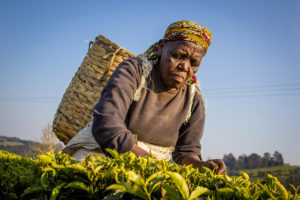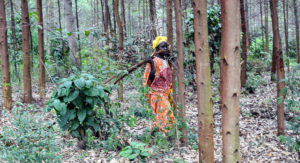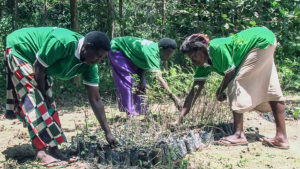
Men and women differ in their preferences when it comes to REDD+ benefits. Men prefer cash incentives while women lean toward non-cash benefits, according to the CGIAR Research Program on Forests, Trees and Agroforestry’s (FTA) Esther Mwangi, a Principal Scientist at the Center for International Forestry Research (CIFOR).
Mwangi and an international team of researchers conducted in-depth intra-household interviews in Tanzania, Indonesia and Peru as part of a work package comprising a larger project on REDD+ and tenure.
Across all three countries, in addition to the benefit preference of men and women, researchers found a correlation between increased women’s participation and more equitable distribution of benefits. But they also found male dominance in different decision-making stages, and that people (mostly men) involved in decisions regarding REDD+ were more likely to be satisfied with the distribution of benefits.
More than benefit preferences, there was a bigger gender difference when it came to having REDD+ information and being involved in the decision-making process on which benefits would be distributed and how, with men much more active. Mwangi presented some of her findings late last year at the IUFRO 125th World Congress. Here she talks about her work and findings in detail.
Read more: Are there differences between men and women in REDD+ benefit sharing schemes?
When you talk about non-cash benefits, what does that include?
Non-cash benefits are material awards other than direct monetary payments. These include construction of classrooms for primary school children, provisions of farming implements, provision of potable water, or even capacity-building in conservation farming.
In Peru, it was interesting to find that even these non-monetary benefits were differentiated by gender. Men preferred construction materials, technical assistance and training, legal assistance and seedlings of non-timber species. Women, on the other hand, preferred objects or utensils for the home, organic gardens, animals to raise, timber tree saplings, textiles and handicrafts. Therefore, even the preferred types of non-cash benefits are differentiated according to gender.
During a community feedback workshop in Tanzania, we asked men and women to tell us what they would want to see done differently if the REDD+ project were to resume in their village. While women wanted non-cash benefits prioritized, they also indicated that these non-cash benefits “touch women’s problems”.
What are some factors keeping women out of REDD+ decision-making?

We found that twice as many men as women were involved in REDD+ decision-making in Tanzania, four times as many men as women in Peru, and about equal proportions of men and women were involved in Indonesia.
Our definition of REDD+ decision-making covered issues such as whether they were involved in the initial decision on whether or not REDD+ should be implemented in their village, and whether they were involved in the design and implementation of REDD+ activities. Most women indicated that they did not know about these matters. For those who did know, they said they were not invited to meetings when those decisions were made.
The asymmetry between men’s and women’s participation in forestry decision-making is often rooted in two inter-related issues. First, forestry institutions and forest resources are generally male-dominated and second, village-level decision-making takes place in the public sphere. Women are traditionally associated with the private sphere of home and family life.
Was it surprising to find that when there was increased women’s participation, there was a more equitable distribution of benefits?
I personally wasn’t surprised, but still I thought it was an interesting result that probably jibes well with other results.
Work in India and Nepal shows that an increased number of women in decision-making roles has good outcomes for forest conditions. Even in the corporate world, research is starting to show that increasing the presence of women in boardrooms is correlated with greater corporate social responsibility and concern for equitable outcomes of investments.
Read more: ACM levels the playing field for women and men in forest-adjacent communities
Regardless of gender, there were pretty low rates of knowledge of REDD+ and involvement in related decisions. Can you tell us more about that?

This is an interesting observation and speaks to the entry point chosen by NGOs, which, in most of the cases, happened to be village leaders. Village leaders are crucial and should always be approached when setting up projects and interventions in rural areas. However, more effort should be made to ensure greater inclusion, especially if women and others (including men) are frequently marginalized in decision-making. This extra effort should be made even if village leadership is widely respected and legitimate.
When asked what should happen differently if the REDD+ pilots were to be repeated, both men and women in Tanzania made clear that REDD+ education should be provided on a door-to-door basis. This would help raise awareness and widely disseminate information.
This is a reasonable demand and probably good for interventions, because if people don’t know what exactly REDD+ is and why it’s being implemented, (that is, make the connection between REDD+ benefits and forest conservation) it’s unlikely that these schemes will achieve their goals. Moreover, lack of involvement in decision-making weakens the legitimacy and sustainability of the schemes.
What are the next steps for work on this topic?
Benefit-sharing arrangements should be designed with gendered differences in mind. This cannot be overemphasized, because these benefits constitute an important incentive for sustainable management and even conservation.
In previous work, we demonstrated that greater gender equity is possible in the forestry sector both in participation in decision-making and in the distribution of forestry benefits. Lessons from this work would be invaluable in informing the design and implementation of benefit-sharing arrangements.
By Christi Hang, originally published at CIFOR’s Forests News.
This research forms part of the CGIAR Research Program on Forests, Trees and Agroforestry, which is supported by CGIAR Fund Donors.














